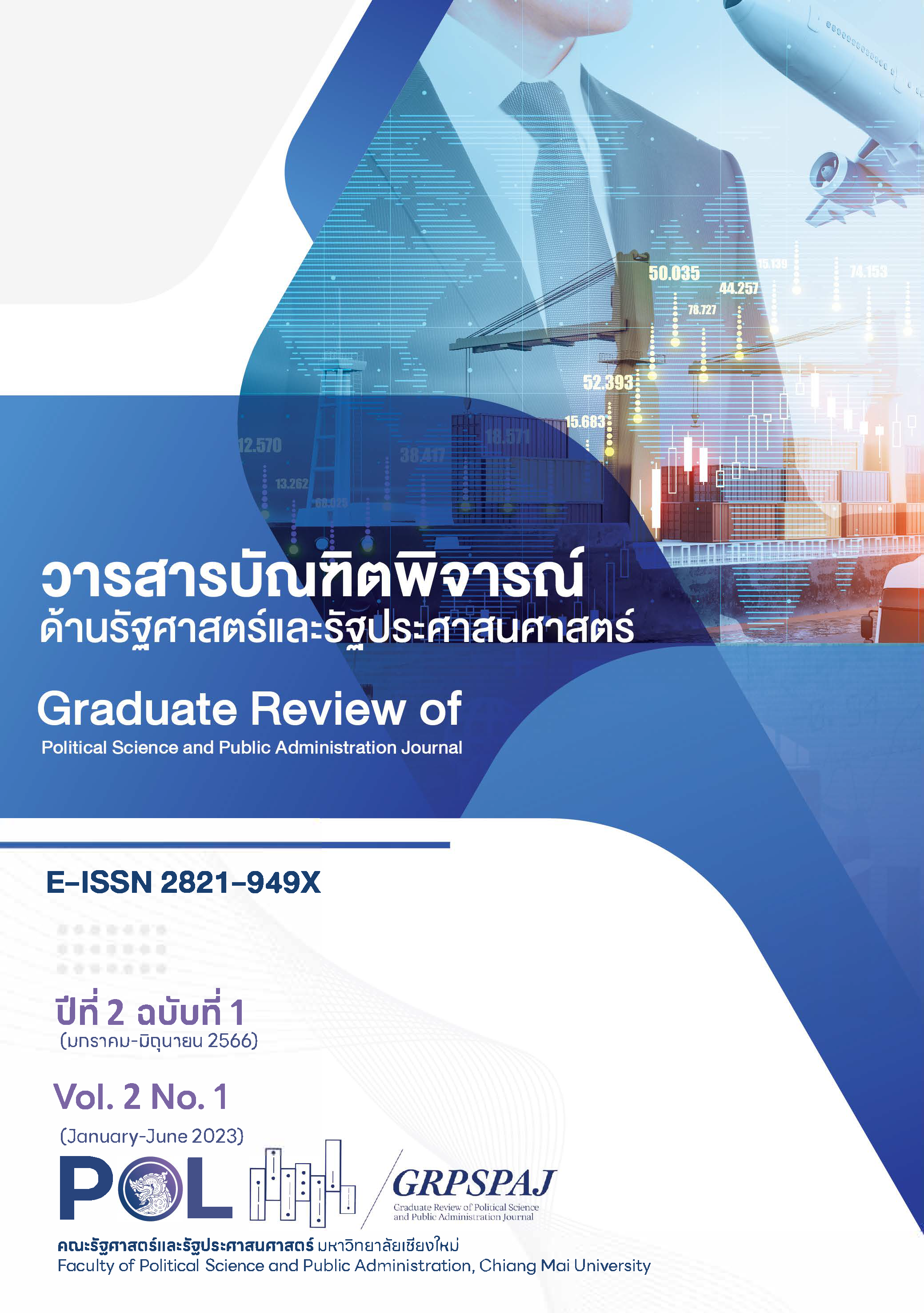The China-United States Trade War: Changing Roles and Balance of Power in the United States
Main Article Content
Abstract
The China–United States trade war reflects the preservation of American power status through economic and foreign policy towards China. It reveals a desire to maintain an original power status. Therefore, factors related to the economic role of the United States (US) and the balance of power in the US change according to world economic development. For this reason, this article aims to study: 1) economic policies significant for maintaining US power status; 2) the US role in technological competition; and 3) US understanding of how to maintain power and economic status through asymmetrical theory and realism, including related research on the role of the economy and geopolitical-geoeconomic analysis. Results were that the US balance and its economic role are challenged and shifting. Chinese rise in technological competition and economic growth incites US competition. To maintain leadership, technological roles must be strengthened. However, economic conditions may be insufficient for maintaining the status quo. U.S. foreign policy developments may be needed to maintain U.S. global leadership in maintaining international relations and providing financial assistance to developing nations.
Article Details

This work is licensed under a Creative Commons Attribution-NonCommercial-NoDerivatives 4.0 International License.
Graduate Review of Political Science and Public Administration Journal is licensed under a Creative Commons Attribution-NonCommercial-NoDerivatives 4.0 International (CC BY-NC-ND 4.0) licence, unless otherwise stated. Please read our Policies page for more information...
References
กฤษณา ไวสำรวจ, และรังสรรค์ สุคำภา. (2564). สงครามทางการค้าสหรัฐอเมริกา-จีน: ปฐมเหตุการต่อสู้แข่งขันและผลกระทบ. วารสารปาริชาต, 34(1), 253-258.
จิตติภัทร พูนขำ. (2553). พินิจทฤษฎีความสัมพันธ์ระหว่างประเทศแนวสัจนิยมใหม่ (Neorealism): ว่าด้วยความเป็นเจ้าของสหรัฐอเมริกากับดุลแห่งอำนาจในยุคหลังสงครามเย็น. วารสารสังคมศาสตร์, 4(1), 1-31.
ชลดา เศวตศิลา. (2562). ความสัมพันธ์ระหว่างประเทศด้านเศรษฐกิจของจีน-สหรัฐอเมริกา (ค.ศ. 1978-2015). วารสารรัฐศาสตร์พิจาร, 6(12), 153-176.
ธโสธร ตู้ทองคำ. (2559). แนวคิด ทฤษฎี ตัวแบบและแนวทางการศสึกษาความสัมพันธ์ระหว่างประเทศ: การจัดกลุ่มทางความคิดและสาระสำคัญจากแนวคิดกระแสหลักช่วง คริสต์ศตวรรษที่ 20. วารสารรัฐศาสตร์และรัฐประศาสนศาสตร์, 7(2), 129-133.
บรรจง ไชยลังกา. (2559). ระเบียบโลกใหม่ของจีน: วิเคราะห์ตามทฤษฎีสัจนิยมใหม่. วารสารสถาบันวิชาการป้องกันประเทศ, 7(2), 19-29.
ปริญญา นวลเปียน. (2563). ทฤษฎีความขัดแย้งแบบอสมมาตร: การพิจารณาเกี่ยวกับกลยุทธ์และผลลัพธ์. วารสารรัฐศาสตร์พิจาร, 7(13), 3-6.
ประชาชาติธุรกิจ. (12 ธันวาคม 2565). TSMC ผุดโรงงานชิปขั้นสูงในสหรัฐฯ ส่อการค้าเสรี โลกาภิวัตน์สิ้นสุดแล้ว?. ประชาชาติธุรกิจ. https://www.prachachat.net/ict/news-1146248
ปิติ ศรีแสงนาม. (27 พฤษภาคม 2562). จากสงครามการค้า สู่สงครามเทคโนโลยี และการช่วงชิงความเป็นผู้จัดระเบียบโลก. The101.World. https://www.the101.world/from-trade-war-to-tech-war/
อิสริยะ ไพรีพ่ายฤทธิ์. (23 พฤศจิกายน 2564). ปัญหาชิปขาดตลาด ผลสะเทือนต่อภูมิรัฐศาสตร์โลก. The101.World. https://www.the101.world/whats-behind-the-chip-shortage/
อาร์ม ตั้งนิรันดร. (7 มิถุนายน 2562). สงครามการค้าจีน-สหรัฐฯ จะจบอย่างไร?. The101.World. https://www.the101.world/next-step-of-us-and-china-trade-war/
Pagon Gatchalee. (26 พฤษภาคม 2562). สงครามการค้า ‘จีน-อเมริกา’: สงครามแห่งการสูญเสียของทุกฝ่าย. TheMatter. https://thematter.co/thinkers/china-vs-usa-trade-war/77688
Breuninger, K. (2022, December 15). U.S. Slaps Restrictions on Chinese Chipmaker and Other Companies Over National Security Worries. CNBC. https://www.cnbc.com/2022/12/15/us-slaps-restrictions-on-chinese-chipmaker-and-other-companies-over-national-security-worries.html
Becker, E. S., Fischer, A. N., Moeller, V. E., Oresman, M., & Rosenberg, T. S. (2020, October 29). Trump vs. Biden: An International Trade Briefing. Pillsbury. https://www.pillsburylaw.com/en/news-and-insights/election-international-trade-trump-biden.html
Dorsey, M. J. (2019). Trump’s Trade Wars: A New World Order? (Mideast Security and Policy Studies No. 166). JSTOR. http://www.jstor.com/stable/resrep24339
Flanagan, L. P., Strosnider A. K., Lichtenbaum, P., Carlson, E., Rademaker, S., Goldstein, A. C., S.-Z., Eric., Bartenstein, C. S., Williams, N. J., Johnson A. L., & Garth, C. (2022, October 10). U.S. Imposes Additional Export Controls Restrictions on Advanced Computing and Semiconductor Manufacturing Items. Covington. https://www.cov.com/en/news-and-insights/insights/2022/10/us-imposes-additional-export-controls-restrictions-on-advanced-computing-and-semiconductor-manufacturing-items
Grieco, K. A. (2022, January 19). The China-US Space Race Is a Myth. TheDiplomat. https://thediplomat.com/2022/01/the-china-us-space-race-is-a-myth/
Hu, W. (2020). The United States, China, and the Indo-Pacific Strategy: The Rise and Return of Strategic Competition. The China Review, 20(3), 127-142.
Hang, N. T. T. (2017). The Rise of China: Challenges, Implications, and Options for the United States. Indian Journal of Asian Affairs, 30(1/2), 47-64.
Jain, R. (2018). China’s Economic Expansion in South Asia: Strengths, Challenges and Opportunities. Indian Journal of Asian Affairs, 31(1/2), 21-36.
Kluger, J. (2022, August 26). China Will Ultimately Overtake the U.S. in Outer Space, A New Study Warns. Time. https://time.com/6208992/china-us-space/
Kurecic, P. (2015). Geoeconomic and Geopolitical Conflicts: Outcomes of the Geopolitical Economy in a Contemporary World. World Review of Political Economy, 6(4), 522-543.
Levine, A. D. (2020). Made in China 2025: China’s Strategy for Becoming a Global High-Tech Superpower and its Implications for the U.S. Economy, National Security, and Free Trade. Journal of Strategic Security, 13(3), 1-16.
Mishra, V. (2022, September 8). From Trump to Biden, Continuity and Change in the US’s China Policy. Observer Research Foundation. https://www.orfonline.org/research/from-trump-to-biden-continuity-and-change-in-the-uss-china-policy/
Mastanduno, M. (2009). System Maker and Privilege Taker: U.S. Power and the International Political Economy. World Politics, 61(1), 121-154.
Nellis, S., Freifeld, K., & Alper, A. (2022, October 10). U.S. Aims to Hobble China's Chip Industry with Sweeping New Export Rules. Reuters. https://www.reuters.com/technology/us-aims-hobble-chinas-chip-industry-with-sweeping-new-export-rules-2022-10-07/
Rasmus, J. (2018). Trump's Deja Vu China Trade War. World Review of Political Economy, 9(3), 346-363.
Taillard, M. (2018). Economics and Modern Warfare: The Invisible Fist of the Market (2nd ed.). Palgrave Macmillan.
Willige, A. (2016, December 5). The World’s Top Economy: the US vs China in Five Charts. World Economic Forum. https://www.weforum.org/agenda/2016/12/the-world-s-top-economy-the-us-vs-china-in-five-charts/
Zhang, Y. (2018). The US–China Trade War: A Political and Economic Analysis. Indian Journal of Asian Affairs, 31(1/2), 53-74.

